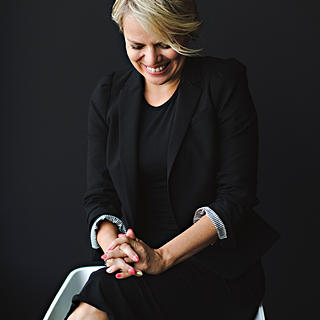Architect to Artist: How Stephanie Boutari Found Freedom in Murals
- cgoucher
- Mar 9
- 4 min read
Updated: Aug 31
What makes someone trade a structured career for the uncertainty of art? For Stephanie Boutari, it wasn’t just about loving murals, it was about pushing creative boundaries. We talked career pivots, self-doubt, and why posting on social media is scarier than rock climbing.
If you’ve ever questioned your creative path, this one’s for you.
What was the spark that drew you to murals, and how has your passion evolved?
It was probably a combination of my love for art and architecture! While studying architecture, I was inspired by the creative uses of colour and pattern in spaces and facades, as well as public art. I had always enjoyed painting on canvas, and murals bridged those two interests.
At first, I began painting murals as part of my architecture thesis—approaching paint as an architectural material and exploring its possibilities to transform the surface of a building and, therefore, how it is experienced, perceived, and its architectural and urban identity. After graduating from the MArch program, I continued to work in the field as an architectural designer for a few years, but during that period I had a few opportunities to create more murals in my free time.
Eventually, the appeal of making art, combined with the stress of my job at the time, pushed me to quit and pursue art full-time. Since then, I have been primarily painting murals for a wide array of clients. Now, after seven years, a lot of my work has been for more commercial interests, but my passion for art-for-art's-sake, and art in the public realm, has always remained. I am currently learning to find the balance between client work to make a living and personal projects that fuel my creativity.
Can you share a project or piece that you hold close to your heart? What’s the story behind its importance for you?
Despite being probably my smallest mural ever (about 8 x 13 feet), one of my first projects as a freelance artist (two months after leaving architecture) was a piece I did in Goudies Lane in downtown Kitchener. It was painted for the BIA as part of a live-art event alongside other artists. The initiative intended to activate the street as a pedestrian laneway—there was live music, food, and the addition of street furniture and pavement painting.
It was a pivotal moment for me as an artist—I got to witness firsthand the power of public art to foster community, but also, the mural itself seemed to take on a life of its own after the event, becoming a local icon of sorts. It brought me joy to see so many different people and businesses photograph it and interact with it over the years, and it was on the cover of DTK Own It's magazine that year.
How do you navigate creative blocks or periods of low inspiration?
That's something I still struggle with sometimes; often, it occurs when I'm feeling burned out or under too much stress—so I try to pause if I can and take time to do relaxing things to 'reset' my brain, like long walks in nature or reconnecting with friends.
In situations where I'm feeling stuck with designs for a client and I don't have the luxury of time, I try to 'ride the wave' so to speak. I tell myself—this isn't working the way I want it to right now, but I know it eventually will; it always does—I just need to keep working at it, to keep showing up. It's a matter of having faith in myself and not letting the panic or imposter syndrome take over. Sometimes that also means letting go of an initial idea that isn't turning out the way I imagined and not being afraid of that lost time—it's a necessary part of the process.
What have you done lately that scared you?
As an introvert, going to the Design Thinkers conference in Toronto! And unrelated to art, but rock climbing (indoors). I do think there's something creatively beneficial about doing any sort of activity that challenges you because it trains your brain to be resilient and believe you can do difficult things. And to be honest, every time I post on social media, I think I feel more scared than when I do the actual work—there's a vulnerability to putting yourself out there for public comment and feedback.
What is the best advice you have been given?
To stay curious—to consistently choose curiosity over fear. Passion isn't always there, but curiosity is more important for creativity—you can be curious every day. Your curiosity is different from everyone else's and will create a life unique to you.
And finally, what’s something you are looking forward to? Finishing setting up my new studio and beginning to work there! For the first time, I have my own dedicated artist studio space, and I'm very excited to use it. I will still continue to paint murals, but having this space will allow me to explore smaller-scale works and perhaps have a healthier boundary between my living space and workspace!
Know someone with a creative spark?
I’m always looking for inspiring people to feature in 6Qs with Christine. If you know a creative thinker, maker, or storyteller whose journey deserves a spotlight, send me a note! I’d love to hear from you.








